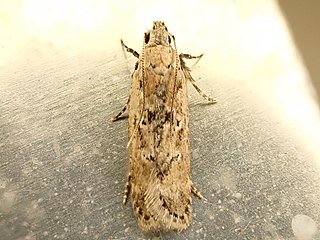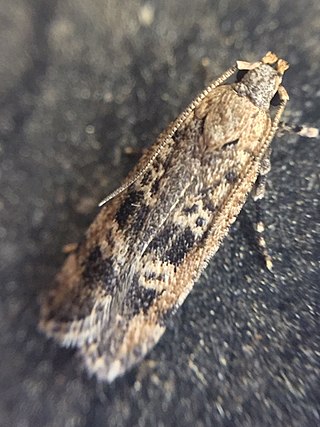
The Tortricidae are a family of moths, commonly known as tortrix moths or leafroller moths, in the order Lepidoptera. This large family has over 11,000 species described, and is the sole member of the superfamily Tortricoidea, although the genus Heliocosma is sometimes placed within this superfamily. Many of these are economically important pests. Olethreutidae is a junior synonym. The typical resting posture is with the wings folded back, producing a rather rounded profile.

The cinnabar moth is a brightly coloured arctiid moth found as a native species in Europe and western and central Asia then east across the Palearctic to Siberia to China. It has been introduced into New Zealand, Australia and North America to control ragwort, on which its larvae feed. The moth is named after the red mineral cinnabar because of the red patches on its predominantly black wings. The species was first described by Carl Linnaeus in his 1758 10th edition of Systema Naturae. Cinnabar moths are about 20 mm (0.79 in) long and have a wingspan of 32–42 mm (1.3–1.7 in).

The flannel moths or crinkled flannel moths are a family of insects. They occur in North America and the New World tropics.
The Prodoxidae are a family of moths, generally small in size and nondescript in appearance. They include species of moderate pest status, such as the currant shoot borer, and others of considerable ecological and evolutionary interest, such as various species of "yucca moths".

Notodontidae is a family of moths with approximately 3,800 known species. The family was described by James Francis Stephens in 1829. Moths of this family are found in all parts of the world, but they are most concentrated in tropical areas, especially in the New World.

The dun-bar is a moth of the family Noctuidae. It is a common Palearctic species.

Gracillariidae is an important family of insects in the order Lepidoptera and the principal family of leaf miners that includes several economic, horticultural or recently invasive pest species such as the horse-chestnut leaf miner, Cameraria ohridella.

Anacampsis is a worldwide genus of moth with most found in the nearctic and neotropical regions. It is in the family Gelechiidae. The larvae feed on a range of deciduous trees and shrubs in a rolled or folded leaf, or spun shoot.

Cosmia is a genus of moths of the family Noctuidae.

Cosmia diffinis, the white-spotted pinion, is a moth of the family Noctuidae The species was first described by Carl Linnaeus in 1767. It is found in central and southern Europe, to the north it is found up to central England and the southern parts of the Netherlands. There is a disjunct population in Gotland. To the south, it is found down to Spain, Italy, Russia, northern Greece and Bulgaria. In the east, it is found as far as Lithuania and the Black Sea.

The lesser-spotted pinion is a moth of the family Noctuidae. It is found in central and southern Europe, north to Great Britain, Denmark, southern Sweden up to Saint Petersburg. East, its range extends through northern and Central Asia up to Japan. It is also found in north-western Africa.

Cosmia pyralina, the lunar-spotted pinion, is a moth of the family Noctuidae.

The Erebidae are a family of moths in the superfamily Noctuoidea. The family is among the largest families of moths by species count and contains a wide variety of well-known macromoth groups. The family includes the underwings (Catocala); litter moths (Herminiinae); tiger, lichen, and wasp moths (Arctiinae); tussock moths (Lymantriinae), including the arctic woolly bear moth ; fruit-piercing moths ; micronoctuoid moths (Micronoctuini); snout moths (Hypeninae); and zales, though many of these common names can also refer to moths outside the Erebidae. Some of the erebid moths are called owlets.

Cosmia restituta is a moth of the family Noctuidae. It is found in the Russian Far East, Korea, Japan, Nepal and Taiwan.
Meridarchis cosmia is a moth in the Carposinidae family. It was described by Alexey Diakonoff in 1954. It is found in New Guinea.

Acraga is a genus of moths of the family Dalceridae.

Anisoplaca achyrota is a species of moth in the family Gelechiidae. It was first described by Edward Meyrick in 1885 and is endemic to New Zealand. This species has been observed in both the North and South Islands and inhabits native forest. The larvae of this species feed on the green seeds of Hoheria angustifolia and as such is regarded as an indicator species for mature native forest. The adults of the species are commonly on the wing from December until February and are attracted to light.

Anisoplaca cosmia, also known as the Norfolk Island hibiscus moth, is a species of moth in the family Gelechiidae. It was described by John David Bradley in 1956 and is native to Norfolk Island but has become established in New Zealand.
Cosmia elisae is a species of cutworm or dart moth in the family Noctuidae. It is found in North America.

Cosmia praeacuta is a species of cutworm or dart moth in the family Noctuidae.
















